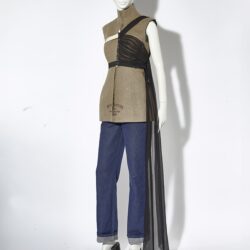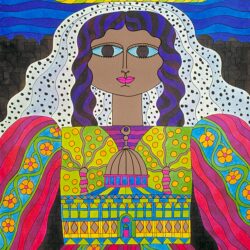Yvonne Dekock & Walter Van Beirendonck: Talent is something you recognize instantly

It wouldn’t be an understatement to say that both Yvonne Dekock and Walter Van Beirendonck dedicated their lives to fashion. While they graduated from Antwerp’s Royal Academy of Fine Arts during the early 1980s, none of them could have foreseen their long-term involvement and important roles within the fashion department, which come to an end this year.
It turns out that the ongoing practice of fashion education can be just as rewarding and inspiring as creativity itself. We sat down with Van Beirendonck -who has been Head of the Fashion Department since 2007- and Dekock -who teaches Graphics within the first three years- to discuss core beliefs and values when it comes to their teaching at the Academy, acknowledging talent when they see it, and why fashion education should never have to burden itself with the logics of commerciality.

How do you remember most of the teaching while you were students at the Academy?
YVONNE DEKOCK: "It was fairly old-school at the time, and a lot of the teaching was focused on how we should behave properly as individuals. We couldn’t wear our hair loose or put our hands in our pockets during class. In a way, we rebelled against some of those principles and created a group of our own."
WALTER VAN BEIRENDONCK: "I guess it was nice to have teachers who were so focused on those notions of elegance and good taste, because it gave us something to go up against and deconstruct. Mary Prijot was obsessed with Chanel, and hiding certain body parts such as knees or elbows. It was all about what she considered ugly or indecent, and how to avoid this. Without that discipline, we wouldn’t have had the structure to create our own world."
Did Marthe Van Leemput share a similar taste?
WVB: "No, Marthe was more a hippie type and eventually became our friend. She taught us how to stitch and work with patterns."
YD: "It was lovely to have lunch with her and develop a friendship over the years."
I started teaching in 1985 and was almost the same age as the students I taught, which was kind of odd. I never thought I would stay there for another 25 years.
It sounds like the teaching itself was more formal, but you could still grow relationships with your teachers after graduation.
YD: "Definitely."
Were their values completely different from the ones you have been conveying yourselves?
WVB: "The teaching itself is rather comparable when it comes to the process of research and how to develop a collection from scratch. Of course, the technology and tools used by the students are completely different today, but the core values and approach to that creative process still stand."
YD: "I agree. It was with great passion and idealism that we got involved in fashion. Society was changing and we were a part of that change."
WVB: "You need to bear in mind that classes were much smaller then and fashion was therefore more local. As designers, we felt like we had to get out of Belgium to find our way and become successful."
Was fashion education regarded seriously then?
YD: "Well, fashion certainly wasn’t."
WVB: "But I believe education was. Although fairly new -the department had existed for around 10 years when we started studying there- Marthe and Mary clearly had strong ambitions for Belgian fashion and considered it as relevant and important as painting or sculpture."
YD: "That was great of her, because she really thought of fashion highly and people noticed."
People do take fashion seriously here, and I get the feeling that Belgians are also proud to support Belgian designers. At the same time, the level of fashion education in Belgium seems quite high.
WVB: "I’d agree that the level is indeed high compared to other countries."
YD: "And it has grown over the years, too. The enthusiasm and energy we had then is still the same today."
How did you see your own roles as educators when you started teaching at the Academy, and what was the first thing you wanted to express?
YD: "Freedom, first and foremost. I often felt suffocated as a student and didn’t want my students to experience that, so I gave them the confidence to believe in their abilities and assert their own personalities. The most important thing is that they find themselves in the end."
WVB: "I started teaching in 1985 and was almost the same age as the students I taught, which was kind of odd. I never thought I would stay there for another 25 years."
YD: "Same for me."
Did you enjoy it from day one?
WVB: "Yes, I did. And I also realized I could get into the student’s mind and push him or her to the point they wanted to reach."
YD: "It’s all about empowering someone in the teaching and be generous with that person."
Do you recognize talent when you’re in front of it?
YD: "Oh yes. I can’t even explain it, it’s that little something…"
WVB: "Personality is very important and you feel it rather strongly. You will find many students who develop specific abilities, but there are only a few for whom it seems natural. You see them grow steadily and tend to remember them afterwards."
Besides empowering the students and giving them the knowledge they need, how do you handle their ego, and what do you think of it?
WVB: "We don’t really work with egos and try to avoid them. Ego is a dangerous thing and can prevent you from growing."
YD: "Ego takes away some of the creativity and curiosity, too. I think ego stands in the way of personal growth, especially if it’s too dominant."
WVB: "You don’t want students to become lazy or complacent. That doesn’t mean you won’t praise them either, but when you do, it should always be in a measured way."
What do you think students expect from fashion schools today?
WVB: "Students know everything nowadays. We were like virgins compared to them."

What do you mean by ‘everything’?
YD: "Well, they have Internet (she laughs). I mean, our students are so saturated with images now that they don’t really see nor feel them anymore."
I believe that a reference isn’t valid until you’ve made it your own. Perhaps that’s the problem they face.
WVB: "It’s just on the surface, so we push them to come up with exact references and credits every time they want to use a specific image."
What do you tell them about social media?
WVB: "It’s the easy way, but we also encourage them to go through books and visit libraries."
How has the pandemic affected your teaching?
WVB: "It hasn’t been easy to connect with students over the past two years."
YD: "The students lost that family feeling, which makes it harder for them. It affects their creativity, too. I’d say they become less daring as a result."
WVB: "Some played it a little safe. At the same time, our world is not reassuring either."
The fashion landscape has become increasingly commercialized over the past 10 years. Should education take commerciality into account?
YD: "I think the only time students think about that is during their Master’s."
WVB: "Our goal is to push creativity as much as we can, and not consider the industrial aspects of fashion today. We were criticized for this a few years ago, but creativity is all that matters to us."
Are the students well prepared once they graduate from the Academy?
YD: "They have to learn a lot, but they know what to say about themselves."
WVB: "They can stand up for themselves and survive that world. From the 1st year onwards, they are used to talking to people they don’t know, and defending their work. They need to be able to explain things, but also justify themselves."











